We arrived into St. Helena after an 11-night, 1,713nm passage from Cape Town. Conditions were somewhat rough for the first few nights, but calmed down considerably after. For the rest of the way into St. Helena, we had light winds and condtions so calm it hardly felt like we were at sea. En route, we crossed the Prime Meridian and returned to the western hemisphere after two and a half years away.
We ran slower than we usually do on this psssage to explore fuel economy at very low power levels. Our interest in doing this was driven by our considering a direct run from St. Helena to the Caribbean. The 3,650 nautical mile passage between St. Helena and Barbardos is at the very limit of Dirona‘s range. Generally, we have no experience at these speeds, so we probed the upper end of the speed required to ensure we could achieve the needed fuel economy to actually complete the trip. At an average speed of 6.14nm/hour, we consumed 1,047 gallons, yielding a fuel economy of 1.64nm/gal. This is even better than the 1.5nm/gal needed for the Caribbean trip, so we’re feeling more confident we can make the trip.
Trip highlights from December 28th to January 4th follow. Click any image for a larger view, or click the position to view the location on a map. And a live map of our current route and most recent log entries always is available at http://mvdirona.com/maps
 |
At the helm
Position: 8 14.34, -27 30.37
Spitfire and James sharing the helm chair. Spitfire has really taken to sleeping there and seems perfectly happy with James squished up against him.
|
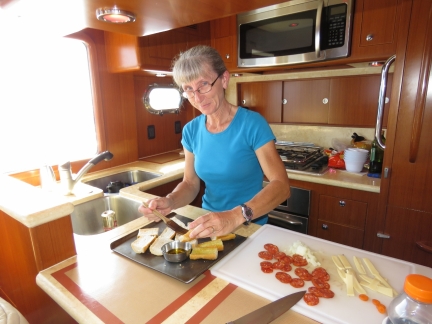 |
Polynesian Pizza
Position: 7 35.59, -27 2.89
Jennifer making what we call “Polynesian Pizza” for dinner. We first started making this dish in the Marquesas, with the abundant baguettes there.
|
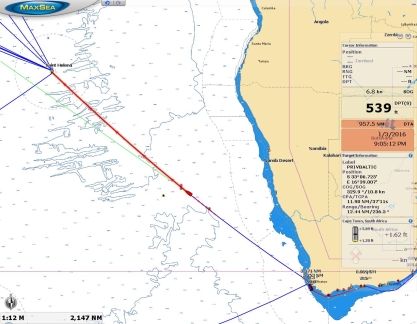 |
Below 1,000
Position: 6 55.72, -26 34.49
We’re less than 1,000 miles out of St. Helena now. The weather forecasts still look excellent and conditions remain calm with light swell.
|
 |
Valdivia Bank
Position: 6 29.07, -26 14.90
We’re crossing through Valdivia Bank now, where depths drop from 16,000ft to under 800ft. Freak breaking waves have been reported here, possibly a combination of the sudden shallow water and strong winds against the Benguela current. The wind was SE 15-20, with no perceptable change in sea conditions, as we passed through the bank.
|
 |
Seamount
Position: 6 21.20, -26 9.02
After not producing a sounding for days, our depthsounder is clearly showing the seamount that rises to within 800ft of the surface.
|
 |
Flying fish
Position: 5 55.17, -25 49.52
This flying fish is the first sea life we’ve seen since leaving Cape Town. Save for the occasional sea bird, we’ve not seen much life of any kind for days.
|
 |
BGAN
Position: 5 52.78, -25 47.72
Last night we passed outside the coverage area of our always-on KVH mini-VSAT satellite data system. Connectivity was suprisingly good right up until we left the coverage area. We’ll be connecting only briefly a few times a day via Immarsat BGAN until we re-enter KVH mini-VSAT coverage near the Brazilian coast en route to Barbados.
|
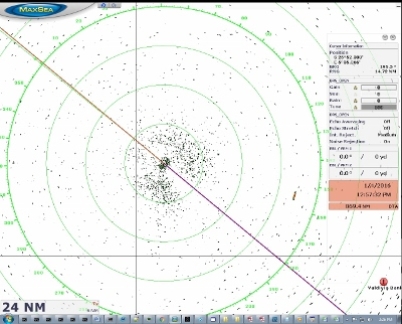 |
Ship
Position: 5 40.05, -25 38.17
We picked up a ship on radar over 24nm behind us, running roughly on the same course and closing quickly. We guessed it might be the RMS St. Helena that supplies St. Helena and Ascension Island via Cape Town, or perhaps a cruise ship en route to Brazil from Cape Town via St. Helena. We sure love our Furuno 25kW radar–it picks up targets at amazing distances.
|
 |
Bomar Resilient
Position: 5 31.62, -25 31.85
The ship behind us turned out to be the Bomar Resilient en route to New York City. It passed about seven miles to our north.
|
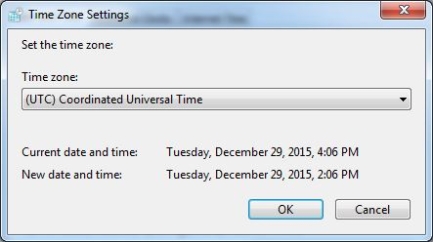 |
GMT
Position: 5 31.46, -25 31.72
We just switched our clocks back two hours to the St. Helena timezone: Greenwich Mean Time.
|
 |
Conditions
Position: 3 41.24, -24 7.62
Conditions remain excellent, with winds below 10 knots and the waves about 5 feet on 7 seconds. And sea conditions are forecast to improve to below 4 feet on 8 seconds as we near St. Helena. On this leg, our goal is to show that we comfortably can hit the 1.5nm/gal that we need in order go successfully complete the planned 3,650nm of the next leg to Barbados. All good so far.
|
 |
Boat wash
Position: 3 38.94, -24 5.80
The boat was a little dirty from our last few days in Cape Town and lots of salt spray from the first two days underway, so James gave the boat a quick powerwash today. Its so much nicer to be able to walk around outside and not get return covered in salt.
|
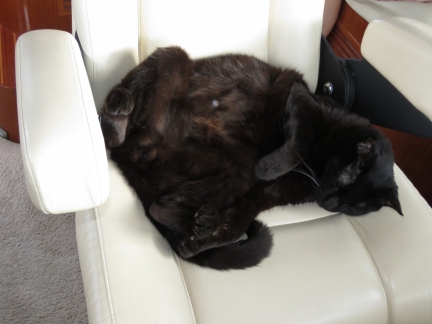 |
Relaxed
Position: 3 18.37, -23 49.53
Everyone is enjoying the settled weather, especially Spitfire.
|
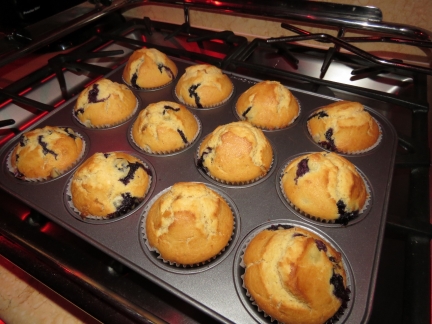 |
Muffins
Position: 2 20.13, -23 3.28
Fresh-baked blueberry muffins for breakfast.
|
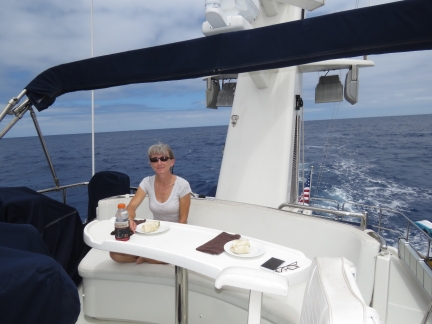 |
Lunch
Position: 1 33.96, -22 26.43
With the boat clean and conditions so calm, we had lunch on the flybridge and lingered for a few hours after.
|
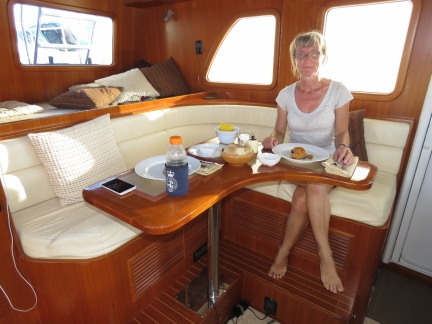 |
New Year’s Eve
Position: 1 11.83, -22 8.13
Roast peri-peri chicken for a special New Year’s Eve dinner.
|
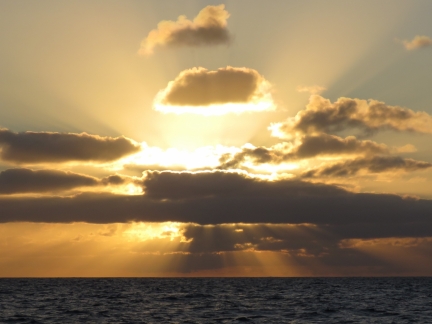 |
Happy New Year
Position: 1 7.38, -22 4.43
The last sunset of 2015. Happy New Year.
|
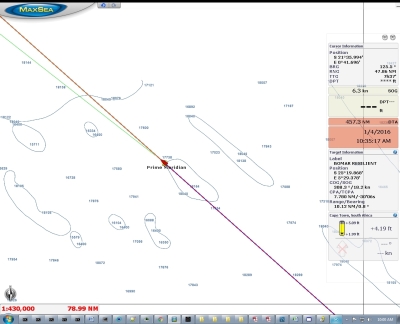 |
Prime Meridian
Position: 0 0.17, -21 8.19
We just crossed the Prime Meridian and transitioned from the eastern to the western hemisphere.
|
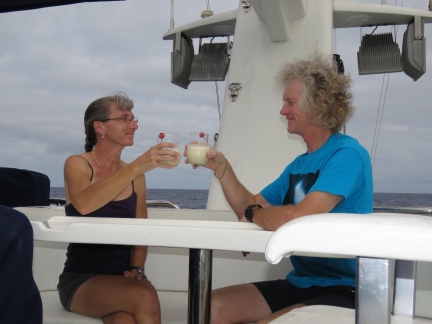 |
Celebrate
Position: 0 42.56, -20 32.69
Virgin pina coladas before dinner to celebrate crossing the Prime Meridian and returning to the western hemisphere after two and a half years away. We crossed from west to east on the passage to Fiji in July of 2013.
|
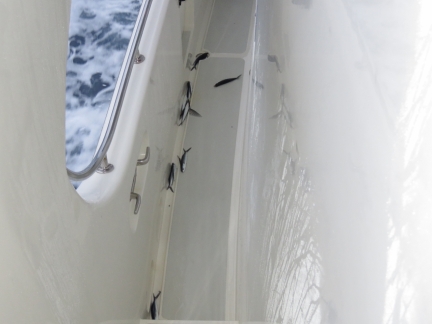 |
Flying fish
Position: -1 45.45, -19 38.57
The boat was literally covered in flying fish this morning. We found at least 20 on deck.
|
 |
Morning coffee
Position: -2 9.01, -19 18.08
Jennifer enjoying a morning coffee in our big, new coffee mug courtesy of the Amazon QLDB team.
|
 |
Conditions
Position: -2 39.93, -18 51.09
Conditions have improved slightly as expected, and are just wonderful. Seas are below five feet, with winds around 10 knots, and pitch and roll are barely noticeable. The speed and fuel economy have been somewhat variable, but are great right now as we’re making 7 knots at 1.78 nm/gallon. ((The check light and external alarm lights are on due to underway maintenance.)
|
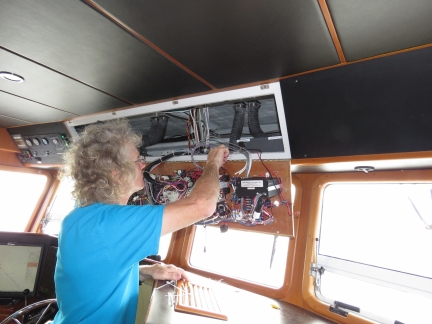 |
Start alternator
Position: -2 43.20, -18 48.24
James is making the change to take the start alternator parallel circuit from semi-automatic to full programmatic control with a manual switch override.
|
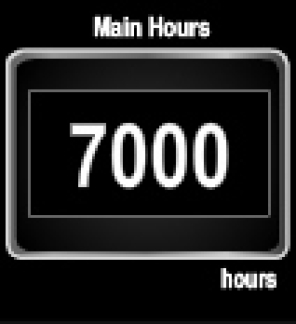 |
7,000 hours
Position: -2 51.46, -18 41.03
We just hit 7,000 hours on the main engine. It’s hard to believe our “new” boat has 7,000 hours on it.
|
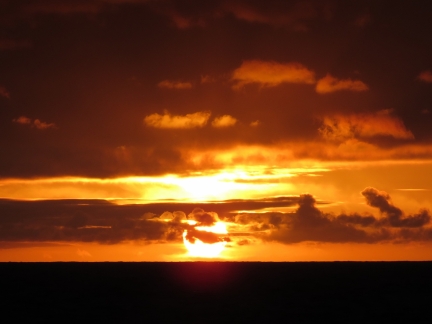 |
Sunset
Position: -2 51.54, -18 40.96
.
|
 |
Below 200
Position: -3 39.23, -17 58.80
We’re less than 200 miles out of St. Helena now and can see the island and the boat together on the chartplotter.
|
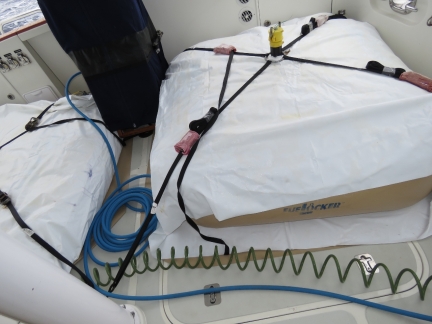 |
Bladders
Position: -4 11.38, -17 29.78
We’re in the process of draining the cockpit bladders. The port bladder still is full, but the starboard bladder now is partially empty. The blue hose attaches to a fitting on the starboard bladder near the cockpit door and snakes across the floor to the bulkhead fitting. (See Fuel for the Crossing for details of our fuel transfer process.)
|
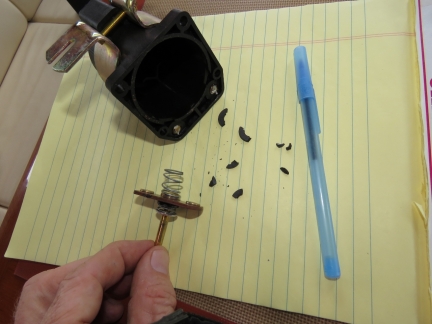 |
Relay failure
Position: -4 20.81, -17 21.27
Our start alternator parallel relay, despite being the “biggest, smokin’est” 24v relay on the market, failed today. We don’t have a spare, so James took it apart to see if he could fix it. The connector plate slide (in James’ hand) had melted slightly, causing the relay to jam on, and the insulator broke up at the connector slide plate. Both issues are heat-related. James did manage to rebuild it and get it operational again, but we really need a new one.
|
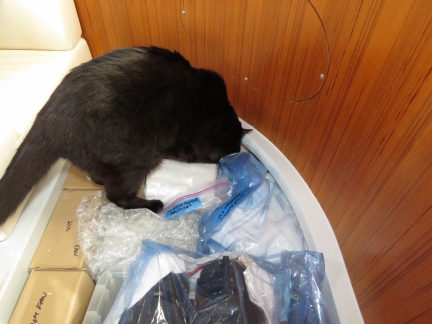 |
Storage
Position: -4 26.96, -17 15.69
We got a muffin fan out of storage under the pilot house settee to cool the start alternator relay when in use. Whenever we open up a storage area, Spitfire is in there instantly. He knows our storage areas better than we do.
|
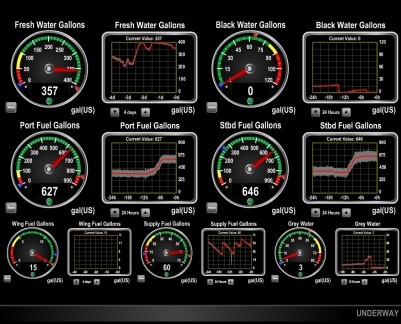 |
Bladders drained
Position: -5 2.41, -16 43.56
Both bladders are drained and we’re back to nearly full tanks again.
|
 |
Radar
Position: -5 12.79, -16 34.15
We’re less than fifty miles out of St. Helena now and the island is showing up clearly on the radar.
|
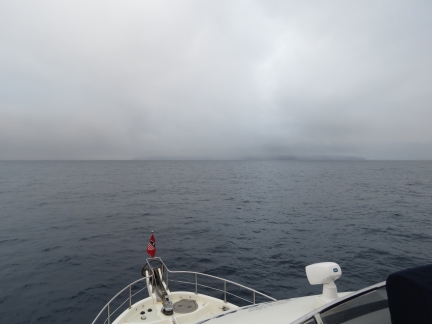 |
Land Ho!
Position: -5 39.94, -16 9.46
We can just barely make out St. Helena about 15 miles away.
|
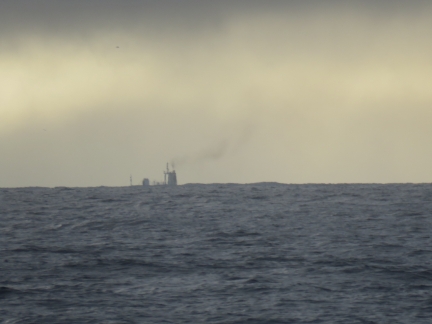 |
The RMS
Position: -5 42.77, -16 6.89
The RMS St Helena, known localy as just “the RMS”, is arriving this morning from Cape Town as well. They’re doing 14 knots, so made the trip in less than half our time. The ship actually left St. Helena the day we left Cape Town and has been there and back in the time we travelled here.
|
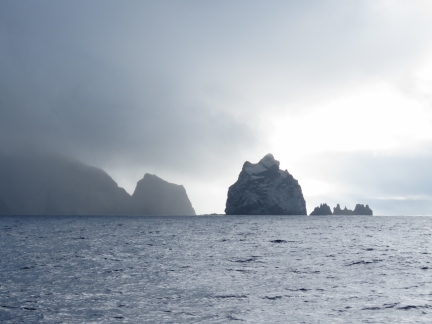 |
Speery Island
Position: -5 47.14, -16 1.88
Looking east to Speery Island on St. Helena’s ruggerd southern coast.
|
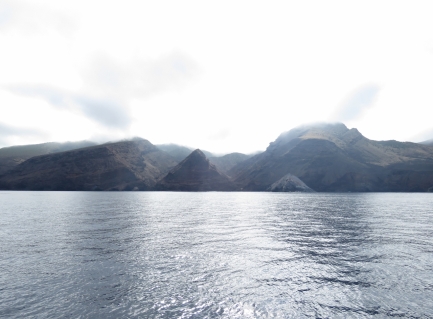 |
Egg Island
Position: -5 46.97, -15 57.92
The small grey island on the right is Egg Island and on either side of the central peak are Swanley and Old Woman’s Valley. We were disappointed that the island was so shrouded in clouds and we might not get a view of the dramatic shoreline, but the visibiliy is improving as we approach.
|
 |
Harbour Master
Position: -5 45.92, -15 56.88
We called Radio St. Helena when we were within 20 miles of arriving then later called the Harbour Master for a buoy assignment as we neared Jamestown.
|
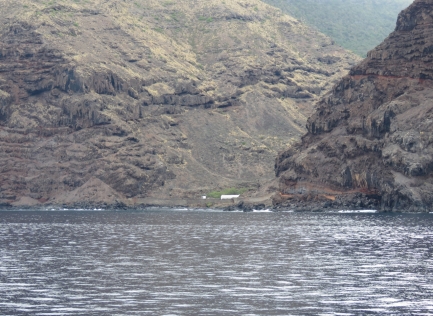 |
Quarantine Station
Position: -5 44.96, -15 56.13
The old Quarantine Station in Lemon Valley.
|
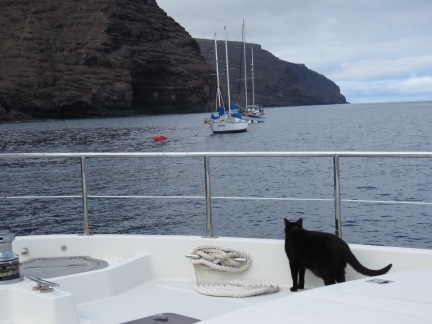 |
Moored
Position: -5 43.51, -15 55.49
Spitfire inspecting our mooring. He’s always concerned when he can see other boats nearby. We normally don’t use a buoy, as most seem to be rated for 20 tons, but the new moorings at St. Helena can handle 50 tons.
|

|
Click the travel log icon on the left to see these locations on a map, with the complete log of our cruise.
On the map page, clicking on a camera or text icon will display a picture and/or log entry for that location, and clicking on the smaller icons along the route will display latitude, longitude and other navigation data for that location. And a live map of our current route and most recent log entries always is available at http://mvdirona.com/maps. |
If your comment doesn't show up right away, send us email and we'll dredge it out of the spam filter.

Glad to learn your concerns about the fuel usage for distance traveled panned out using lower speeds James; especially since the weather factor can throw all those calculations out the window. Hoping you and Jennifer continue to enjoy calm waters and safe voyages this year.
You are right Stewart. Currents, weather, sea conditions, boat speed, boat weight (goes down as fuel burns), measurement error, and mechanical system problems all conspire to make it very difficult to be 100% worry free on the having the fuel needed for a given trip. I must posted considerably more data on how manage this measurement problem in a comment to the Fuel Economy and range posting. I’ll eventually convert that write up into a full blog entry.